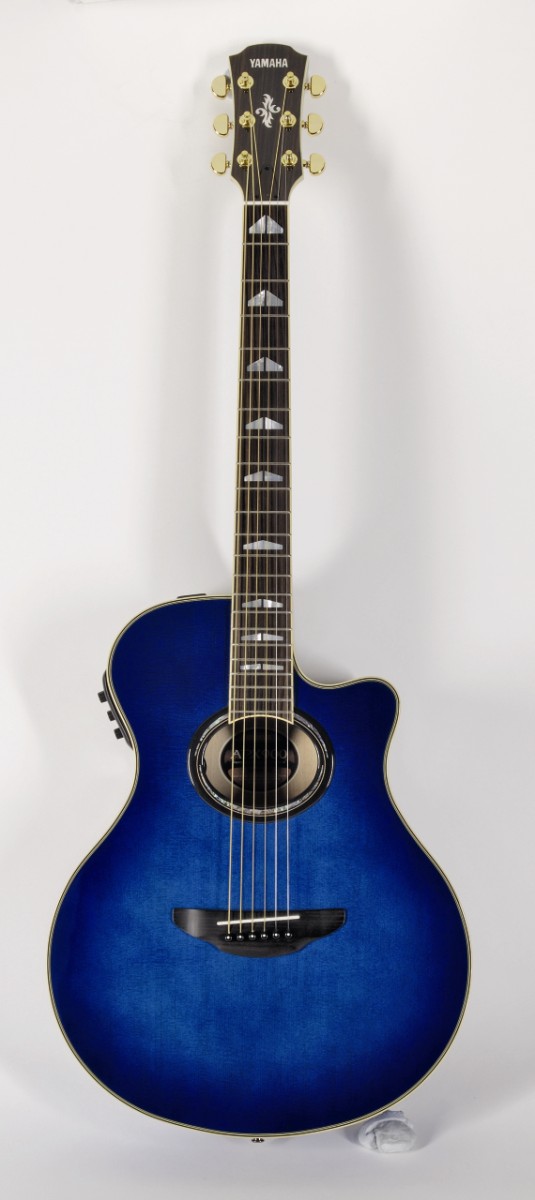MusicRadar Verdict
Essentially a deluxe version of the 700 - but a danmed good upgrade.
Pros
- +
Pretty much everything. The natural smoothness of ART sounds compared to the old under-saddle piezo arrangement. plus the sheer expressive lift of the three-way ART system.
Cons
- -
Slight onboard tuner dither but good accuracy nonetheless.
MusicRadar's got your back
Yamaha's APX stage electros have undergone periodical revamps since their launch 20 years ago, and the company's mini-jumbo CPXs, debuted in 1998, have also seen various changes and model substitutions.
However, the new generation of each series is more concise than ever. The APX intros, replacing the entire previous line-up, number only three models, while the new CPX roster is just two strong (albeit supplemented by continuing production of the higher-end Jap-made CPX15 and its cosmetic variants).
Aside from the introduction of a lower-cost, conventional piezo-loaded APX500, the main focus of attention is on the new powering system for the other new guitars - the APX700 and 900, and CPX700 and 900.
Dubbed ART (Acoustic Resonance Transducer) and apparently three years in development, Yamaha's exclusive system is based around piezo crystal technology, but instead of a normal under-saddle strip pickup, it's incorporated into a multilayer contact sensor that's both body and string sensing.
The multilayer aspect, involving a sandwich of rubberised and metallic layers, is designed to achieve the optimum balance between a natural, dynamic, low-distortion sound and sufficient damping to stiife feedback.
ART comes in two forms. On the APX and CPX700, it's a single-unit dual sensor mounted just forward of the underside of the bridge and linked to a one-way, three-band, mid-sweepable preamp.
Overview
On the 900 models, this pair of sensors is augmented by two further single ones, either side of the rear of the bridge and specifically tuned for high- and low-frequency response respectively.
Want all the hottest music and gear news, reviews, deals, features and more, direct to your inbox? Sign up here.
The companion preamp is a three-way affair, allowing individual gain control of these auxiliary sensors, plus there's a master arrangement of volume and three-band EQ. Both the new preamps include an onboard tuner.
According to Yamaha, one of the crucial facets of the systems' testing was establishing the best placement to hit the 'sweet spots'. Consequently, this part of the build process is aided by a simple jig to ensure that the sensors are located under the tops in exactly the same positions every time.
Aside from its three-way ART system and the fact that the guitar's back and sides are laminated flamed maple, not nato, the APX900 is essentially a deluxe version of the 700.
This entails gold rather than chrome tuners, and an upgrade of the bridge and fingerboard from rosewood to striped ebony, the latter carrying decorative split pyramid position markers borrowed from Yamaha's CJ jumbos.
Alternative colours are offered too, including our sample's fetching ultramarine blue. The instrument's System 57 preamp occupies the same size housing as the 56, the only layout difference being that the mid sweep is sacrificed to make room for the two rotary gain knobs that control the bass- and treble-side sub-sensors.
Sounds
Based on a quick strum, the APX900 sounds acoustically very similar to the 700. It's only with longer playing that subtle differences emerge.
The plain strings have a slightly mellower edge and the midrange is just a shade firmer, yet smoother. This is perhaps paradoxical for a maple-backed instrument where you might expect some wiriness in the tone, but the timber can also impart an evening-out effect.
Powered up, and before adding the sub-sensors, the 900 performs on a par with the 700. However, dial the subs in to taste and the delivery is lifted to another level.
Dynamics and headroom are noticeably enhanced, and the whole sound assumes a broader image. Sophisticated tonal tailoring is, of course, a key attribute, either adding wallop to the low end, emphasis to the treble or both.
However, the benefits aren't purely tonal, because the sub-sensors enable you to adapt the timbre across the strings to your own technique, where different settings might be desirable depending on whether you're strumming, fingerpicking or using a thumb pick.
Don't bemoan the absence of the mid sweep, by the way. Such is the extent of how the auxiliary sensors can adapt the sound that the sweep would be largely redundant anyway.
Equally praiseworthy is the degree of versatility available, without the need to move the main EQ bands from their flat positions.
The more extensive tonal and dynamic abilities of the three-way ART system may prompt some people to regard the one-way APX700 and CPX700 as poor, comparatively inadequate relations. That would be wholly unfair, though.
These cheaper models not only represent a significant performance and quality step forward from Yamaha's under-saddle powering (which wasn't too shabby anyway), but the pricing difference against the 900s allows potential buyers to make a clear-cut decision.
It really is a case of 'you pays your money and takes your choice', and whichever way you jump, the level of value is totally enticing.
Yamaha's simplicity of pricing is to be applauded too: there are no premiums on the CPXs merely because they're larger instruments - there's just a common price within each model level, so the final part of your decision-making is simply whether you want a big body or a small one.
The quest for developing superior-sounding alternatives to under-saddle strip transducers was arguably kick-started a few years back by Taylor with its Expression System, and competition from other manufacturers is emerging.
What makes Yamaha's answer so convincing and praiseworthy is that not only are these ART systems great quality and simple to use, but that the company has made them immediately affordable, rather than employ a textbook marketing strategy of launching upmarket and then letting the technology trickle down. Three cheers for that!
